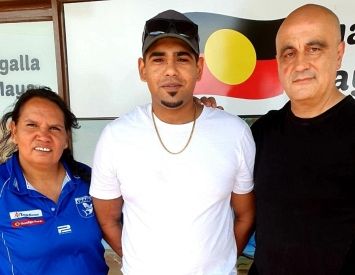Systemic data gaps and secrecy are masking a national crisis in child protection, writes Gerry Georgatos.
*CONTENT WARNING: This article discusses suicide
WHEN THE STATE removes a child from family and assumes guardianship, it takes on the highest protective obligations – fiduciary in spirit if not always in name – backed by statute, policy and public law values.
The state acts as parens patriae and guardian, assumes responsibility for the child’s welfare. When, tragically, the child dies by suicide (or otherwise from unnatural causes) while in state care, the state’s responsibility and potential liability loom large.
Yet in Australia, systematic data on suicides and unnatural deaths among children in state care is fragmented, inconsistent and often hidden from public view. In that posture, every suicide or other unnatural death of a child in care is not only a human tragedy but also a litmus test of legal accountability and system design.
Yet across Australia, there is no uniform, public, disaggregated dataset enumerating suicides of children in care (foster, kinship, residential) by state/territory over time. The data vacuum frustrates prevention, impedes oversight and erodes public trust.
This article surveys what can be gathered from national and state sources, inquiries, and credible journalism; highlights Western Australia (WA) as a case exemplar; and proposes minimum reporting standards so that Australia can finally see – and prevent – what is otherwise obscured.
Legal and institutional frame
Children in out-of-home care (OOHC) are usually under court-endorsed orders placing parental responsibility with the state (or shared with carers). This triggers duties to provide safe placements, therapeutic support and continuity of care.
Coroners have jurisdiction over reportable deaths; the National Coronial Information System (NCIS) aggregates coronial data nationally, but public fields do not routinely flag whether the deceased child was in OOHC at the time of death. Without that flag, national in-care suicide counts are not straightforwardly extractable.
Parallel systems exist in states/territories: child-death registers or review teams, ombudsman-led reviews and departmental annual reports on deaths of children known to child protection. However, most do not publish a yearly figure for suicides of children in care separated from deaths of children merely “known to” the system (a broader cohort).
Baseline: Suicide in children and young people
The Australian Institute of Health and Welfare (AIHW) reports that in 2023 the suicide rate among children aged ≤14 was 0.6 per 100,000, much lower in absolute terms than older cohorts, but still a leading cause of death in youth and a persistent contributor to mortality. These baseline figures, however, do not isolate the OOHC subgroup, which research and practice suggest may face elevated risks due to trauma histories, placement instability, and service gaps.
What the public record shows (and hides)
Despite the gaps, several jurisdictions do publish partial windows into the problem:
- New South Wales (NSW): DCJ’s Child Deaths Annual Reports enumerate deaths of children known to child protection each year (for example, 96 deaths in 2023), but do not transparently extract suicides of children in care as a discrete series. The NSW Ombudsman’s Child Death Review Team issues biennial reports with supplementary reviews of deaths of children in care — an important mechanism, though still not a readily downloadable time-series of in-care suicides.
- Queensland (QLD): The Queensland Family and Child Commission (QFCC) publishes Annual Reports: Deaths of children and young people. In 2022–23, QFCC recorded 20 youth suicides (nine confirmed, 11 probable) across the state — robust public counting, but again this is all children, not an in-care isolate.
- Western Australia (WA): The WA Ombudsman has reported that suicide is the most frequent circumstance of death among young people (13–17) notified to the Ombudsman since the child-death review function began in 2009; 16% of all notified child deaths fell under suicide. Yet WA does not publish a simple annual series of in-care suicides.
- Other jurisdictions (Vic/SA/Tas/NT/ACT): Public documents exist (departmental reports, coronial inquests, occasional reviews), but no routine, disaggregated series of in-care suicides was located at first efforts (I explain later).
A WA case exemplar (2020s)
Credible journalism has illuminated the human stakes in WA. An ABC investigation (11 November 2024) reported that more than 400 children in state care were recorded as victims of neglect or sexual/physical/emotional abuse between 2020–2023; that at least 14 young people in care had died since 2020 (including a 10-year-old boy by suicide and a 14-year-old girl who took her life in a residential group home); and that two others in care had reportedly died by suicide.
The story also described eight-month waits for psychiatric care for a child newly placed in care, carers having to fight for counselling for children, FOI refusals for critical-incident reports and >1,000 vulnerable children without an allocated caseworker as of September 2024.
Separate media and advocacy reporting about 10-year-old suicides in WA (one in March 2016 and another in 2024) underscores the possibility of very young in-care deaths by suicide and the urgency of systemic reform — a point echoed in Ombudsman analyses of youth suicide more broadly.
The WA evidence base – partial, contested, but serious – exemplifies a national problem: harms (including suicides) are measured inconsistently, and often obscured behind “known to the system” aggregates, confidentiality, or FOI denials.
Jurisdictional snapshot (2015–2024)
Caution: Most jurisdictions do not publish a clean, public count of suicides of children in care by year. The table records what is publicly visible and usable for law-reform analysis — not a complete census.
|
Jurisdiction |
Public reporting that can inform in-care suicide analysis |
Illustrative public datapoints (non-exhaustive) |
|
NSW |
DCJ Child Deaths Annual Reports (children known to DCJ); NSW Ombudsman CDRT biennial reports including reviews of deaths of children in care. |
Ninety-six deaths of children known to DCJ in 2023 (mix of causes; not isolated to in-care suicides).
|
|
QLD |
QFCC Annual Report: Deaths of children and young people; Child Death Review Board systemic reports |
Twenty youth suicides in 2022–23 (state-wide; not in-care isolate). |
|
WA |
Ombudsman child-death review; thematic reports on youth suicide; journalism. |
Suicide = most frequent death circumstance for notified 13–17s; 16% of notified child deaths since 2009 = suicide; ABC (2024) details >400 abuse victims in care (2020–23) and 14 deaths in care since 2020 (with specific suicide cases). |
|
VIC / SA / TAS / NT / ACT |
Dispersed reports (departmental, coronial, occasional reviews); no routine, public, in-care-suicide time-series located in this sweep. |
Data likely exists internally; not transparently disaggregated for public analysis. |
Why the numbers matter (and what we already know)
Risk factors for suicidality in OOHC are well-described in clinical and social-work literature: trauma histories; placement instability (some children experience dozens of placements); interrupted therapeutic care; isolation; and, for First Nations children, cultural disconnection.
The ABC’s WA reporting links these risk factors to practical barriers (long waits for psychiatry, absence of automatic counselling), suggesting system design failures that increase risk.
From a public law perspective, opacity itself is a harm: without public, disaggregated reporting (including an OOHC flag in coronial data), no jurisdiction can credibly claim to have learned from its systems or to be accountable. The duty to protect cannot be satisfied by an absence of evidence.
Minimum standards for a national evidence base
- National OOHC mortality flagging (coronial): The NCIS (or relevant agency) should introduce a standard data field indicating whether the deceased was in OOHC (or within 12 months of exiting OOHC) at death; publish annual OOHC-specific suicide and unnatural-death counts, by jurisdiction, placement type, age, sex and Indigenous status.
- State/territory annual OOHC death reports: Each department should table an annual report listing all deaths of children in care, disaggregated by cause (suicide/accident/homicide/natural), placement type, time in care, number of placements and services accessed in the 12 months prior to death.
- Independent child death review powers: Ombudsman/Child Death Review Teams should have explicit statutory mandates to review every OOHC death, publish de-identified findings, and require remedial action plans (with progress tracked publicly).
- Mental health screening and continuity: Mandate initial and periodic suicidality screening for all children entering care; require timely access to psychiatry/psychology (with maximum wait-time standards) and continuity across placement changes.
- Placement-stability triggers: Set hard triggers (for example, fewer than three moves in a year) that compel multidisciplinary case reviews with independent oversight; publish placement-instability metrics alongside death data.
- FOI and critical-incident transparency: Critical-incident reports (including attempted suicides) should be FOI-releasable subject to privacy protections; agencies should publish aggregate incident dashboards.
- Culturally safe care for First Nations children: Embed cultural-connection duties and report culturally safe service access as part of the death-review dataset.
National snapshot (2015–2024) — what’s available by deep dive
I remind most jurisdictions report children known to child protection, few isolate children in care at time of death. Where possible, I’ve called out suicide counts and whether “in-care” is identified.
|
Jurisdiction |
What’s published |
What we can cite now by deep dives |
Does it isolate in-care suicides? |
|
Commonwealth (national context) |
AIHW Suicide and Self-Harm Monitoring; NCIS repository. |
Baseline: very low absolute numbers at ≤14 years (for example, rate context and dashboards). NCIS is the coronial database. |
No national “OOHC/in-care” flag published. |
|
NSW |
DCJ Child Deaths Annual Reports (children known to DCJ); NSW Ombudsman Child Death Review Team (biennial; supplementary reviews of deaths of children in care). |
Ninety-six children known to DCJ died in 2023 (mix of causes). NSW Ombudsman confirms a separate stream reviewing deaths “in care.” |
Partly. Biennial review covers “in care,” but there isn’t a simple year-by-year public table of in-care suicides. |
|
QLD |
QFCC Annual Report: Deaths of children and young people (+ Child Death Review Board). |
Twenty youth suicides in 2022–23 (nine confirmed, 11 probable); 19 in 2023–24 (ten confirmed, nine probable). Total 128 suicides over the past five years (average 26/year). |
No — counts are state-wide, not filtered to in-care at death. |
NSW and Queensland (what the public series shows)
New South Wales publishes annual counts of deaths of children known to the child protection system (for 2023, 96 deaths), but does not publish a discrete year-by-year count of suicides of children in care. The NSW Ombudsman’s Child Death Review Team produces biennial reports and supplementary reviews of deaths in care, indicating a dedicated review stream, even if a simple public in-care suicide table is absent.
Queensland’s QFCC provides one of the most transparent youth-suicide series: 20 deaths by suicide in 2022–23 (nine confirmed; 11 probable), and 19 in 2023–24 (ten confirmed; nine probable). Over five years, 128 young Queenslanders died by suicide (average 26 per year). These totals, however, are state-wide and not restricted to children in care at the time of death.
National baseline (context for rates)
Nationally, AIHW’s monitoring shows very low absolute numbers for suicide at ages ≤14 compared with older cohorts, but still a persistent youth mortality contributor; the NCIS remains the coronial repository yet, critically, does not publish an “out-of-home care” flag that would allow a clean national in-care suicide count from public data.
Conclusion
Australians cannot prevent what they cannot see. The two ten-year-old suicides in WA (2016 and 2024), the ABC’s documentation of hundreds of abused children in care and multiple deaths since 2020 and the Ombudsman’s finding that suicide is the leading death circumstance among WA notified teens together demand a national reckoning.
This article shows that while some jurisdictions (notably NSW and QLD) publish meaningful child-death data, none provide a straightforward OOHC-suicide time-series across a decade.
Until governments create uniform, public, OOHC-flagged mortality reporting, every “strategy” will be built on shadows, and children in the state’s care will continue to shoulder the cost of institutional silence.
If you would like to speak to someone about suicide you can call Lifeline on 13 11 14.
Gerry Georgatos is a suicide prevention and poverty researcher with an experiential focus on social justice.
 This work is licensed under a Creative Commons Attribution-NonCommercial-NoDerivs 3.0 Australia License
This work is licensed under a Creative Commons Attribution-NonCommercial-NoDerivs 3.0 Australia License
Support independent journalism Subscribe to IA.
















